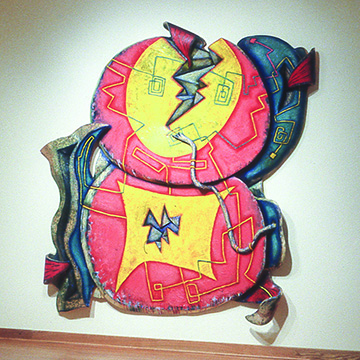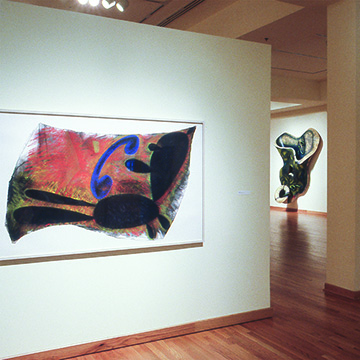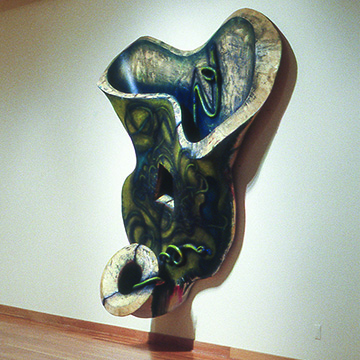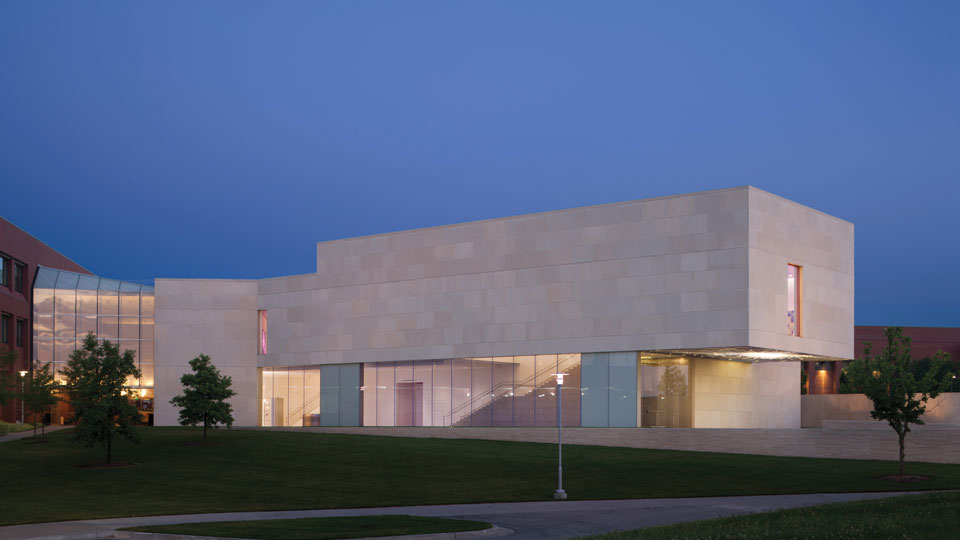Elizabeth Murray
Monumental shaped canvases pop off the walls in the JCCC Gallery of Art’s solo exhibition of Elizabeth Murray’s sculptural paintings. Murray’s art is infused with the spirit of two seemingly incompatible sources: cartoons and Paul Cezanne’s still life paintings. Although Murray attended art school to study commercial illustration, having been drawn to cartooning since an early age, she experienced what might be called a "conversion" in front of a Cezanne painting at the Art Institute of Chicago, and she decided to become a painter.
When Murray paints a table, it comes forward toward us, top first, as if we were birds flying over it. It can seem as big as the roof over a house. For children, whose view of the world is marked by their own reduced scale, a table can be an imaginary shelter or a mountain cave. Cartoons are devised from the child's point of view, not only because children are the intended audience, but because "adult" size is already for them abnormally large. The scale of a coffee cup falling off a table top can seem increasingly distorted to a child on the floor as the cup approaches both the floor and disaster. That cup can also appear to be flying through the air on its own. In Murray's art, the inanimate objects take on animate movements, as if propelled by unseen forces, like wind through a curtain.
The New York-based artist’s 1989 painting Labyrinth is being shown publicly for the first time. Alice Thorson, critic for The Kansas City Star, writes, “the artist said she plans her paintings, making clay models of the shaped elements, and drawing them on big pieces of paper. The structural underpinnings are fabricated by an expert woodworker and then are stretched with canvas. The initial plan for a painting inevitably undergoes several revisions. Murray works intuitively, stream-of-consciousness fashion. ‘The idea reveals itself to me’ is how she explains it. Sometimes the idea that is revealed is wholly unexpected. In conversation, Murray admitted she scared herself with the painting Labyrinth. The shape of Labyrinth, while inspired by a cup, suggests a wildly inflated tuba.”
Elizabeth Murray was born in 1940 in Chicago, and received her BFA from the School of the Art Institute of Chicago and her MFA from Mills College, Oakland, California. Murray received the Skowhegan Medal in Painting in 1986, the Larry Aldrich Prize in Contemporary Art in 1993, and a John D. and Catherine T. MacArthur Foundation Award in 1999. Her work is featured in many collections, including the Nelson-Atkins Museum of Art in Kansas City, Missouri; the Spencer Museum of Art at the University of Kansas, Lawrence; Walker Art Center, Minneapolis; the Museum of Modern Art and the Solomon R. Guggenheim Museum, New York; the Art Institute of Chicago; and the Museum of Contemporary Art, Los Angeles.
The gallery guide features the essay “When Objects Become Events” by Jeff Perrone, artist, New York.
We are most grateful to Elizabeth Murray for her work and for her assistance with this exhibition. Paula Cooper, Natasha Sigmund and Liz Boyle of the Paula Cooper Gallery, New York, are owed special thanks for their contributions to the exhibit. Finally, the Jules and Doris Stein Foundation, Los Angeles, and Marti and Tony Oppenheimer, Kansas City, have our deepest appreciation for their generous support of the exhibition.





